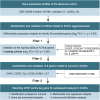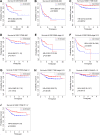CHN1 is a Novel Prognostic Marker for Diffuse Large B-Cell Lymphoma
- PMID: 33833551
- PMCID: PMC8021264
- DOI: 10.2147/PGPM.S301718
CHN1 is a Novel Prognostic Marker for Diffuse Large B-Cell Lymphoma
Abstract
Purpose: Diffuse large B-cell lymphoma (DLBCL) is the most common B-cell malignancy. Thirty to forty percent of DLBCL patients still experience relapse or develop refractory disease even with standard immunochemotherapy, leading to a poor prognosis. Currently, although several gene-based classification methods can be used to predict the prognosis of DLBCL, some patients are still unable to be classified. This study was performed to identify a novel prognostic biomarker for DLBCL.
Patients and methods: A total of 1850 B-cell non-Hodgkin lymphoma (B-NHL) patients in 8 independent datasets with microarray gene expression profiles were retrieved from the Gene Expression Omnibus (GEO) database and Lymphoma/Leukemia Molecular Profiling Project (LLMPP). The candidate genes were selected through three filters in a strict pipeline. Survival analysis was performed in two independent datasets of patients with both gene expression data and clinical information. Gene set enrichment analysis (GSEA) and the CIBERSORT algorithm were used to explore the biological functions of the genes.
Results: We identified 6 candidate genes associated with the clinical outcome of DLBCL patients: CHN1, CD3D, CLU, ICOS, KLRB1 and LAT. Unlike the other five genes, CHN1 has not been previously reported to be implicated in lymphoma. We also observed that CHN1 had prognostic significance in important clinical subgroups; in particular, high CHN1 expression was significantly related to good outcomes in DLBCL patients with the germinal center B-cell-like (GCB) subtype, stage III-IV, or an International Prognostic Index (IPI) score > 2. Multivariate Cox regression analysis of the two datasets showed that CHN1 was an independent prognostic factor for DLBCL. Additionally, GSEA and CIBERSORT indicated that CHN1 was correlated with cell adhesion and T cell immune infiltration.
Conclusion: Our data indicate for the first time that high CHN1 expression is associated with favorable outcomes in DLBCL patients, suggesting its potential utility as a prognostic marker in DLBCL.
Keywords: CHN1; biomarker; diffuse large B-cell lymphoma; prognosis.
© 2021 Sun et al.
Conflict of interest statement
The authors declare that they have no competing interests.
Figures






Similar articles
-
Comprehensive analysis of the prognostic implication and immune infiltration of CISD2 in diffuse large B-cell lymphoma.Front Immunol. 2023 Dec 12;14:1277695. doi: 10.3389/fimmu.2023.1277695. eCollection 2023. Front Immunol. 2023. PMID: 38155967 Free PMC article.
-
Identifying CD1c as a potential biomarker by the comprehensive exploration of tumor mutational burden and immune infiltration in diffuse large B cell lymphoma.PeerJ. 2023 Dec 11;11:e16618. doi: 10.7717/peerj.16618. eCollection 2023. PeerJ. 2023. PMID: 38099311 Free PMC article.
-
Development of a mitochondria-related gene signature for prognostic assessment in diffuse large B cell lymphoma.Front Oncol. 2025 Mar 20;15:1542829. doi: 10.3389/fonc.2025.1542829. eCollection 2025. Front Oncol. 2025. PMID: 40182032 Free PMC article.
-
Diffuse large B-cell lymphoma.Pathology. 2018 Jan;50(1):74-87. doi: 10.1016/j.pathol.2017.09.006. Epub 2017 Nov 20. Pathology. 2018. PMID: 29167021 Review.
-
The significance of FOXP1 in diffuse large B-cell lymphoma.Leuk Lymphoma. 2017 May;58(5):1037-1051. doi: 10.1080/10428194.2016.1228932. Epub 2016 Sep 27. Leuk Lymphoma. 2017. PMID: 27678023 Review.
Cited by
-
Gene expression profiles associated with early relapse during first remission induction in canine multicentric high-grade B-cell lymphoma.J Vet Med Sci. 2024 Jan 10;86(1):18-27. doi: 10.1292/jvms.23-0269. Epub 2023 Nov 13. J Vet Med Sci. 2024. PMID: 37952972 Free PMC article.
-
Comprehensive analysis of the prognostic implication and immune infiltration of CISD2 in diffuse large B-cell lymphoma.Front Immunol. 2023 Dec 12;14:1277695. doi: 10.3389/fimmu.2023.1277695. eCollection 2023. Front Immunol. 2023. PMID: 38155967 Free PMC article.
-
CHN1 promotes epithelial-mesenchymal transition via the Akt/GSK-3β/Snail pathway in cervical carcinoma.J Transl Med. 2021 Jul 8;19(1):295. doi: 10.1186/s12967-021-02963-7. J Transl Med. 2021. PMID: 34238315 Free PMC article.
References
LinkOut - more resources
Full Text Sources
Other Literature Sources
Research Materials
Miscellaneous

